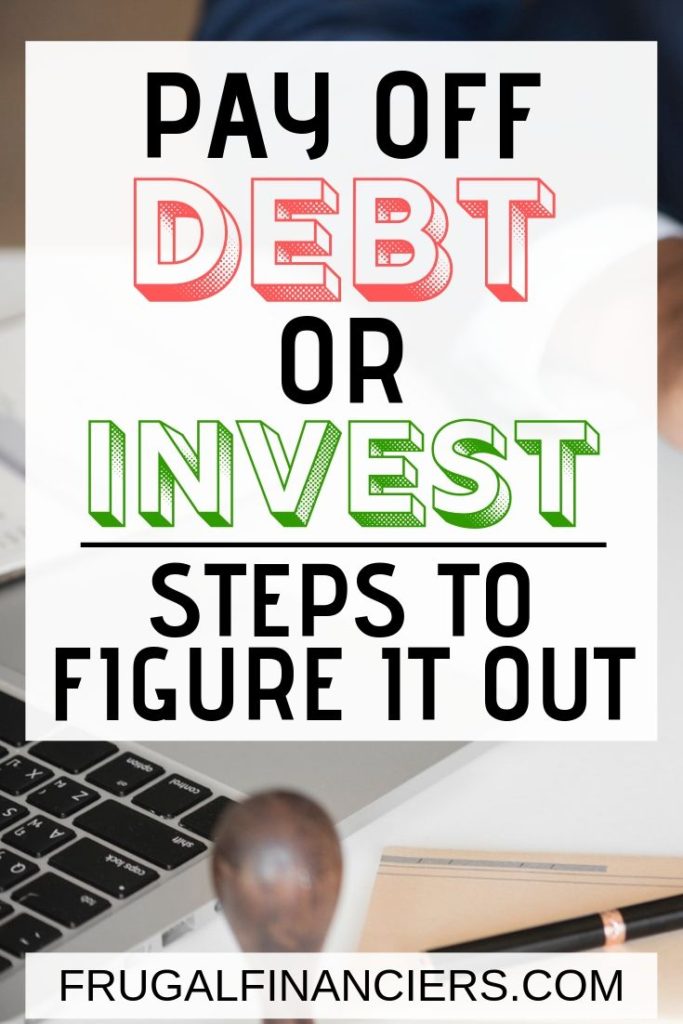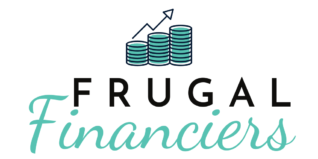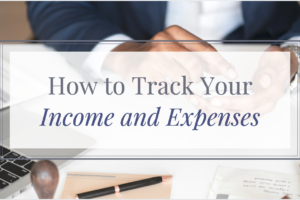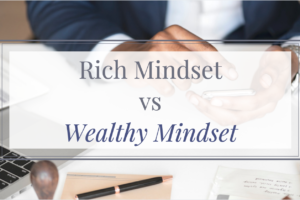You’ve got some extra cash and you’re wondering if you should use the money to pay off your debt or invest it to build your wealth.
Doing both are beneficial for your long-term financial health.
But, it’s hard to know if you should pay off debt or invest, or maybe even a bit of both.
And if you’re doing both, how much of each?
50%/50%?
70%/30%?
40%/60%?
If you are the type of person that sticks strictly to the numbers, there are ways to compare the financial benefits of paying off debt or investing extra money.
And, if you are the type of person who worries about being overwhelmed by debt or missing out on investment opportunities, there are ways to think about the emotions of investing and paying off debt too.
How Do You Think About Your Finances?
Are you the type of person who just wants to see the numbers or,
It is nearly impossible, if not completely impossible to not think emotionally about our personal finances.
At the end of the day, it’s a HUGE part of your life.
Typically, we all fall somewhere on the spectrum from just considering the numbers to considering our emotions when making financial decisions.
The goal isn’t to completely change your mindset but to understand where you are on the spectrum so that you can make a balanced and smart decision.
If your decision-making is closer to the numbers side of the spectrum, have you considered how making a financial decision will make you or others
And, if your decision-making is on the more emotional side have you considered if the emotional feeling is better than spending less money?
It’s a two-step process:
- Understand if your more a numbers person or an emotion person
- Consider the opposite side so that you know you’re making a balanced decision
Using Numbers and Data to Make Your Decision
With debt you pay interest and with investments, you (hope to) earn a return.
What about if you invest $1,000 in debt (like a bond) at a 5% interest rate?
In that case, you’ll make $50 each year on the $1,000 investment.
When it comes to the numbers behind paying off debt and making an investment, the math can be really simple.
One way you make money and the other way you save money.
There can be some complexities that need to be thought through but it’s mostly about comparing numbers and seeing which is the better decision.
So, what information do you need to gather and compare?
Interest Rate and Expected Rate of Return
The star of the comparison show is rate as in interest rate on your debt and the expected rate of return on a potential investment.
Let’s start with the easy one, your debt.
Debt
First, you need to know if your debt is fixed rate or variable rate.
Federal student loans are typically (if not always) fixed.
Credit cards are typically (if not always) variable.
Being fixed or variable interest rate is one of the terms of your loan or line of credit.
A fixed-rate means that the interest rate is set for the life of the loan.
So, a 30-year fixed-rate mortgage at 4.25% translates into paying 4.25% in interest annually on your mortgage for the next 30 years.
A variable-rate means that the interest rate can increase or decrease over the life of the loan.
So, a 5/1 adjustable-rate mortgage (ARM) means that the first 5 years of the loan are fixed and then the loan becomes variable rate, resetting each year.
The variable rate is typically tied to a rate index like PRIME or LIBOR.
The 5/1 ARM might be 3.5% for the first five years and then be 2.5% + one-year LIBOR.
With fixed-rate debt, there isn’t much extra work.
You know how much you’ll save by paying off some of the debt early.
With variable-rate debt, you might have to make some assumptions going forward about where interest rates are going.
Typically, interest rates decrease when the economy is not doing well and increase when the economy is doing well.
It’s probably easier to keep in simple and either assume that you’ll have the same interest rate next year and years after.
Or, be conservative and assume that your loan’s interest rate will increase slightly each year.
For more on paying off debt, check out our post: How to Get Out of Debt | 5 Steps to be Debt Free.
Investments
Figuring out the expected rate of return on investments isn’t really more difficult, it just has more uncertainty.
You expect an investment to grow or pay you a certain amount but its all based on historical information.
There’s no guarantee that an investment will make you money, it could even lose value.
That’s the risk associated with investments that we’ll discuss later on in this post.
When you pay off debt, you are guaranteed to save some money.
But, with an investment it could go up, it could go down, it could stay the same.
Additionally, it could pay you a dividend or interest payment or could totally not pay you a dividend or interest payment.
More on that later.
With an investment, you are trying to make an educated guess about how much it is likely to return.
With a US treasury bill or bond, there is little, if any risk.
So, we can take the interest yield on a Treasury bond or bill, know that we’re going to receive the interest payment set when we bought the treasury.
You buy a 1-year treasury bill with a 2.64% yield and you know that you’ll receive $2.64 on every $100 you invest.
What about corporate debt?
As long as it is a strong investment grade rated company, you’re probably going to get your money back and the yield on the loan.
It’s when we get into stock investments that we start having to make more assumptions due to the uncertainty.
The average annual return of the S&P 500 over the last 100 years or so is 10% annually.
That has a lot of ups and a lot of downs over that period but on average, an investment in a fund that tracks the S&P 500 index would have grown 10% each year.
So, hey we’re done, take the 10% and call it good, right?
The problem is that this is historical performance and historical performance is not an indicator of future results.
You can expect 10% and you may be right and you may be wrong.
Before you just choose an expected return for an investment, do some research.
Sure, find out the historical performance of the investment but also find out what others are saying about the future.
When you’re comparing the interest rate of your debt and the expected return of your investment, remember that one is expected and one is guaranteed.
Time and Compounding
When you’re thinking about whether you should pay off debt or invest, you also need to be aware of time.
When you make a decision, it’s going to affect your debt levels and investments in the future.
Let’s say you have a 5-year loan at 5% (fixed) with a monthly payment and
Hey, you saved yourself $50 bucks over the next year.
But, since you have a monthly payment some of that next payment is going towards the balance rather than to interest last month.
Using some simple math, it’s about $4.17 which equals $50 in 12 months.
So, last month that $4.17 was interest expense but now it’s paying off the
And, guess what, that $4.17 you put towards the balance next month is going to save you $0.21 over the next year.
Yeah, it may not seem like much but as it compounds you pay off your debt faster.
Paying down $1,000 on that loan isn’t going to save you just $50 but it’s also going to save you money on the $50 you don’t have to pay interest on each year.
Instead of saving $250 over the five years, you save somewhere closer to $275 over the next five years.
It’s the same for investing but may be easier to understand.
You put $1,000 into an investment with an expected return of 5% over the next 5 years.
It grows 5% next year to $1,050. Pretty sweet, right?
Well, the next year it isn’t just the $1,000 that’s going to appreciate but also the $50.
Let’s just say it grows another 5% which would mean the new value would be $1,102.50.
You made $2.50 off of that $50 in the next year.
It’s the magic of compounding.
But, why does this matter?
Because you might be comparing your debt interest rate and your expected return on an investment and the rates are pretty close, say 4.50% and 5.00%.
Over a couple of years, that’s not that big of a deal.
At $1,000, over 3 years the difference is about $16.
But, over 15 years?
$143.65
And, 30 years?
$576.62
These numbers might not seem like a lot but remember this is at $1,000.
You must take into account the time horizon and compounding when you’re
Over short periods of time, the difference isn’t as big but over long periods of time, it can become quite meaningful.
Risk
This is in both sections because there are two ways to think about risk when considering paying off debt or investing the money instead.
As we previously mentioned, investments have risks.
Paying off doesn’t unless you consider the fear of missing out a risk.
If anything, paying off debt removes financial risk from yourself.
When you consider paying off debt, you know with 100% certainty you will save.
When you consider an investment, you probably have a level of certainty of how much you might gain and how much you might lose.
It may be worth attaching a value to that 100% certainty.
Tax Implications
There are a bunch of considerations for tax implications both on paying off debt and investing.
Your debt could have tax-benefits you may be able to use as do certain types of investment accounts and even certain types of investments.
Here are some of the common debt and investment products worth looking into to find more out about tax implications.
Debt
- Federal Student Loans
- Home Mortgages
Investments
- Capital Gains Tax
- Plans and Accounts: 401(k), traditional and Roth IRA, HSA
- Municipal Bonds
- Treasury Bonds
Using Your Emotions to Make a Decision
Yeah, kind of a weird title but it’s really all about how you feel about making the decision to pay off debt or invest your extra money.
That’s one of the key differences between personal finance and corporate finance.
How you feel and your life enjoyment matter when making a financial decision.
If you make a financial decision and you feel miserable about it, you’re probably not going to do it again.
Well, unless you felt really great about the decision and then feel miserable about the decision when you see your bank account.
But, that’s for another post.
The Feeling of Paying Off Debt Versus the Feeling of Investing
If you save a bunch of money and put its investments, but then you can’t go out with your friends because of it, you’re probably going to feel terrible.
Future you might be happy, but who cares about the future you because you missed out on socializing and making memories with your friends.
This same dynamic is at play when considering whether to pay off debt or invest money.
What’s the first emotion you have when thinking about paying off your debt.
We’re betting the first feeling you have is a
And, investing?
If the stock market and investing confuse you, it’s probably uncertainty.
Are you making the right decision?
You didn’t even get a chance to get to the positive emotions of investing.
Quit your job, sure.
Take a trip, why not.
Do exactly what you’re doing, … okay, yeah, live your best life.
But, those are all things that are going to happen in the future.
Paying off debt? That’s right now.
We all have stronger feelings towards debt because it’s affecting us right now.
And, that may be reason enough for you to choose to pay off debt instead of investing.
But, try to remember future you if the numbers work out for investing your money instead.
Are you creating short-term happiness but losing long-term happiness in the process?
What About Risk?
Some of us are risk-averse and some of us are risk-seeking.
It can be in your finances and it can be in life.
Just because you’re one way in life doesn’t mean you’re the same with your finances.
But, your overall attitude about risk probably plays out a little in both areas.
So, if you are risk-averse, paying off that debt with guaranteed savings probably sounds pretty nice.
And, if you’re risk-seeking you’re probably still thinking about the 10% annual return we discussed earlier.
Be aware of your tendency to be risk-averse or risk-seeking when you’re making your decision about whether you pay off debt or invest money.
Try to think about it from the other side and ask yourself if you would make the same decision.
Balancing the Numbers and the Emotional Feelings to Make a Decision
At the end of it all, you should make a decision that you feel satisfied and confident in making.
That means gathering all of the financial information between the two decisions.
But, it’s also about gathering your thoughts and emotions about how one decision or the other will impact your mental state.
While investing or paying off debt may clearly be better than the other financially, you also have to consider the emotional feelings of paying off debt versus investing.
Remember, choosing either will almost always improve your long-term financial situation.
One option, you earn and the other, you save but the other might put you in a better mindstate to accomplish even more financial goals.
Use the numbers to compare and start your thinking.
You’ll quickly see if it doesn’t matter because the numbers are so far apart.
Like paying off a credit card balance with an 18% interest rate versus investing in a treasury bond with a 2.5% yield.
But, as the numbers come closer,
Do what feels right.





Leave a Reply
Your email is safe with us.
You must be logged in to post a comment.